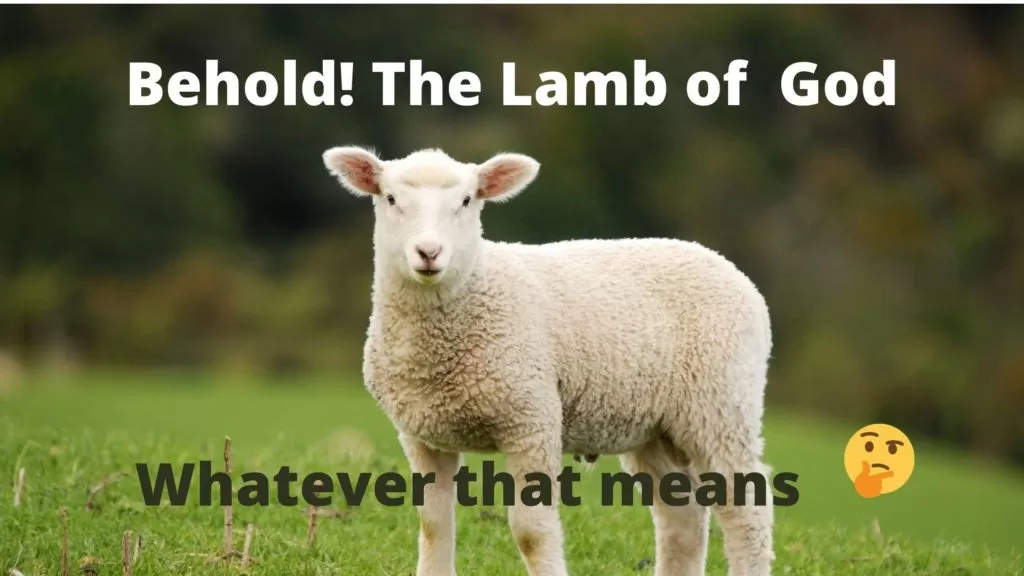Who is Jesus? That is a long story! According to the Bible, he is many things: Alpha and Omega, Advocate, Bread of Life, Bridegroom, Chief Cornerstone, Mediator, Priest, Prophet, and Messiah – just to name a few. In this series of blogs and vlogs, I will be discussing a few of these titles. By doing so, a tapestry Jesus will emerge. I am beginning with Jesus as the Lamb of God.
John the Apostle, tells the story of John the Baptist’s experience when he sees Jesus:
“The next day he saw Jesus coming toward him and said, “Behold, the Lamb of God who takes away the sins of the world.” (John 1:29 ESV).
What is the first thing you think of when you hear the word “lamb?” Probably a cute, white, small baby sheep playfully bounding around a pen or pasture. Although that may be true, the Bible views lambs a bit differently. In many cases, much different.
If you read my last blog, “How to Read the Bible,” you will know that I emphasized the reading of the Old Testament. Part of what I am going to discuss comes from the Old Testament Torah (The Law) but I will give you the scripture references. Especially since we are going to dive into Leviticus and Numbers – you know, two of the books I told you to wait on reading!
Lambs were used as sacrifices for burnt offerings, guilt offerings, and sin offerings. Exodus 29:38 tells us that each day two lambs were sacrificed on the temple altar; one in the morning and one in the evening. In 1 Samuel 7:9, a lamb is used as a burnt offering, Leviticus 14:12 tells us that a lamb was used as a part of a guilt offering, and in Number 6:14 a lamb was used for a sin offering.
What Was Up With The Animal Sacrifices?
In short, animals were used in the place of people. We are a flawed bunch of crazy, wild, and sinful individuals. We do stupid stuff and say terrible things and we just aren’t able to control every aspect of our lives at all times. In other words, we aren’t perfect, but God is. God is also merciful and in His mercy, he made a way for people to be forgiven. Before Jesus came God used animals such as lambs, rams, bulls, and birds in our place.
The Passover Lamb: A Foreshadowing
If you read my other blogs you know I talked about Old Testament events that foreshadow the New Testament. In other words, the Old Testament provides a blueprint for what is to come.
Exodus tells the story of, well, the exodus! The Jews were held as slaves in Egypt for four hundred and thirty years until God raised up Moses as a deliverer. Pharaoh and all of the Egyptian people were subject to ten plagues. The final plague is the one we are going to discuss concerning Jesus.
The last plague was the death of the first born. However, God gave the Jewish people instructions to avoid this plague.
In Exodus 11:4-6, Moses is speaking to Pharaoh warning him about what is to come:
4 So Moses said (to Pharaoh), “Thus says the Lord: ‘About midnight I will go out in the midst of Egypt, 5 and every firstborn in the land of Egypt shall die, from the firstborn of Pharaoh who sits on his throne, even to the firstborn of the slave girl who is behind the handmill, and all the firstborn of the cattle. 6 There shall be a great cry throughout all the land of Egypt, such as there has never been, nor ever will be again.
The Jews were not subject to all of the first nine plagues. God made a distinction between Egypt and the land of Goshen where the Jews lived. Now we see Moses is giving Pharaoh fair warning that God is about to start wiping out the firstborn. Moses returns to Goshen where God gave him instructions for the Jews concerning this plague. The scripture passages are long so I am only going to include Exodus 12:21-28 but I encourage you to take the time to read the full chapters in Exodus. Don’t just take my word for it!
21 Then Moses called all the elders of Israel and said to them, “Go and select lambs for yourselves according to your clans, and kill the Passover lamb. 22 Take a bunch of hyssop and dip it in the blood that is in the basin, and touch the lintel and the two doorposts with the blood that is in the basin. None of you shall go out of the door of his house until the morning. 23 For the Lord will pass through to strike the Egyptians, and when he sees the blood on the lintel and on the two doorposts, the Lord will pass over the door and will not allow the destroyer to enter your houses to strike you. 24 You shall observe this rite as a statute for you and for your sons forever. 25 And when you come to the land that the Lord will give you, as he has promised, you shall keep this service. 26 And when your children say to you, ‘What do you mean by this service?’ 27 you shall say, ‘It is the sacrifice of the Lord’s Passover, for he passed over the houses of the people of Israel in Egypt, when he struck the Egyptians but spared our houses.’” And the people bowed their heads and worshiped.
What Does This Have to do with Jesus?
Let’s connect the dots. We have discussed the fact that animal sacrifices were made to cover the sins of the people. On the first Passover, thousands of years ago, God made a way of escaping death. He used the blood of a lamb that was applied to the doorframes of the Israelites homes. This blood caused death to pass over them.
Approximately fourteen hundred years later Jesus shows up and is about to begin his earthly ministry. He heads to the Jordan River to get baptized by John. John sees him coming and exclaims, “Behold, the Lamb of God who takes away the sins of the world!”
Three years later, Jesus finishes his time on earth with what Christians call Holy Week. Holy Week begins on Palm Sunday and ends with the Resurrection. Let’s look at the parallel between the first Passover and Jesus as the Passover lamb.
The First Passover
Exo 12:3 says: “Tell the whole community of Israel that on the tenth day of this month each man is to take a lamb[a] for his family, one for each household,” and Exo 12:6 says: “Take care of them until the fourteenth day of the month, when all the members of the community of Israel must slaughter them at twilight.”
These two verses provide the timeline of the lamb which was chosen on the 10th and killed on the 14th. The four days in between were for inspecting the lamb to be sure it didn’t have any flaws. On the 14th at dusk, they killed the lamb. It is important to note that during Jesus’ time the killing of the lambs was no longer done by individuals but rather, by the priests at the temple in Jerusalem.
Jesus
Jesus knows his time of crucifixion has come, and he enters Jerusalem for the last time. John 12:3 tells the story of Jesus riding a donkey into Jerusalem while the crowds waved palm branches, hence the name “Palm Sunday.” It is the 10th of the month, the same day the Israelites are choosing their lamb. This will be followed by four days of inspecting the lamb.
The religious leaders of that day hated Jesus and spent the next four days scrutinizing him. Jesus then celebrated, “The Last Supper,” which was Passover. From there he is arrested, beaten, mocked, and crucified. The following are historical facts that are not found in the Bible. At the temple, the lambs were brought to the priests in three waves. When the final lamb was killed, the priest declared “it is finished.”
In John 19:30 Jesus says, “It is finished,” and then dies (but not for long!) Jesus made this declaration at the same time the priests made their declaration. I could keep going as there are many parallels between Jesus and the Passover lamb. To sum it up quickly, Jesus’ timeline during Passover follows the same timeline as the lambs the priests were slaughtering. The death of Jesus also ended the need for animal sacrifice (Hebrews 10: 1-18 Read it!).
The blood of the lamb on the first Passover caused a spirit of death to pass over. The death of Jesus provides the same option for anyone who chooses to take it. The death Jesus saves people from is not on this earth – we are all going to die. The death he is saving us from is in the next life. Many people think that hell is a party barge, but nothing could be further from the truth. It is a place of unending torment. If you think you will be in Heaven because you are basically a good person, you are believing a lie. Have you ever lied? Lying is a sin and the payment for sin is (eternal) death (hell) (Romans 6:23). Pro 12:22 says God hates liars. The only way to be forgiven is through Jesus. And here’s how that works according to Romans 10:9:
If you declare with your mouth, “Jesus is Lord,” and believe in your heart that God raised him from the dead, you will be saved.
You don’t have to do that now, but you should meditate on it as the “Who Is Jesus” series continues!



